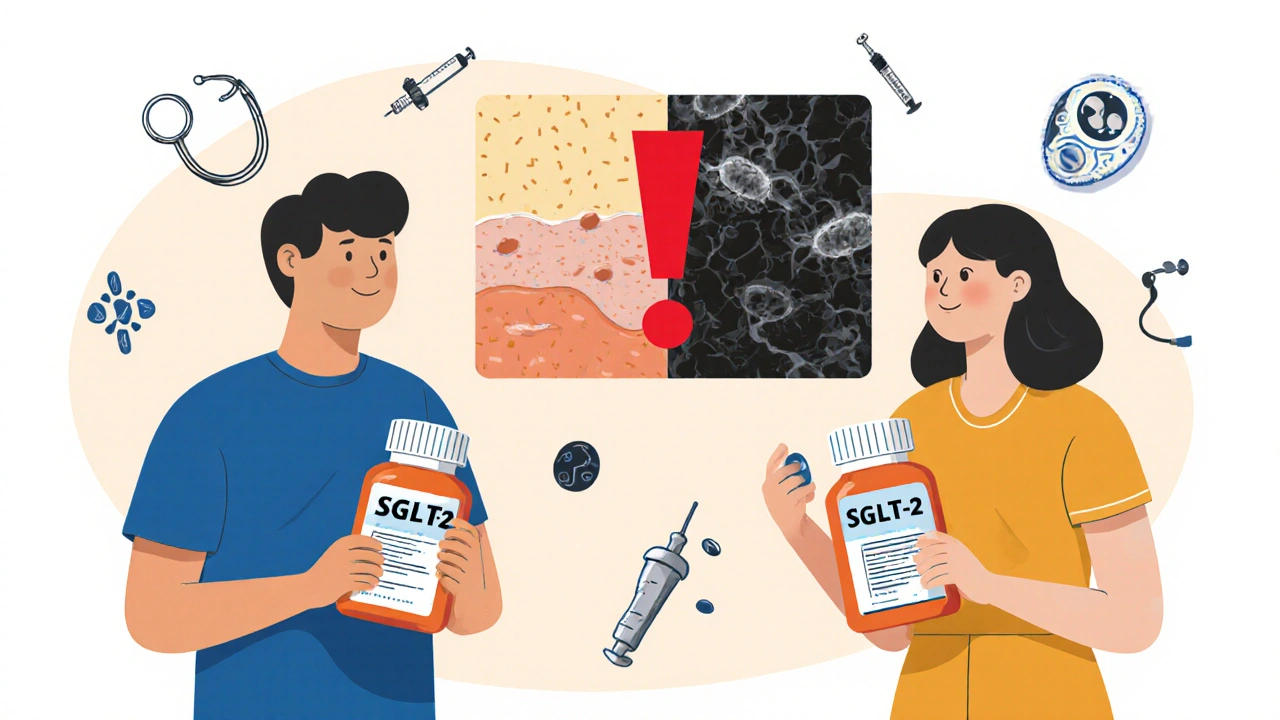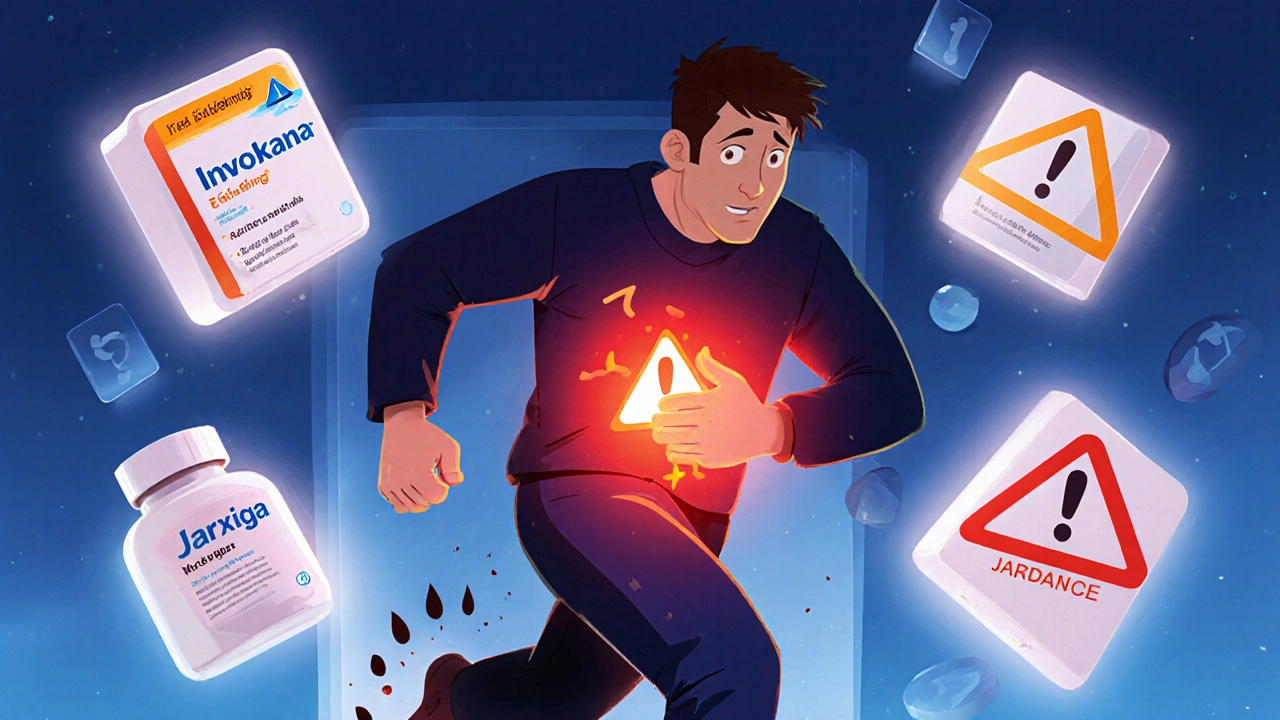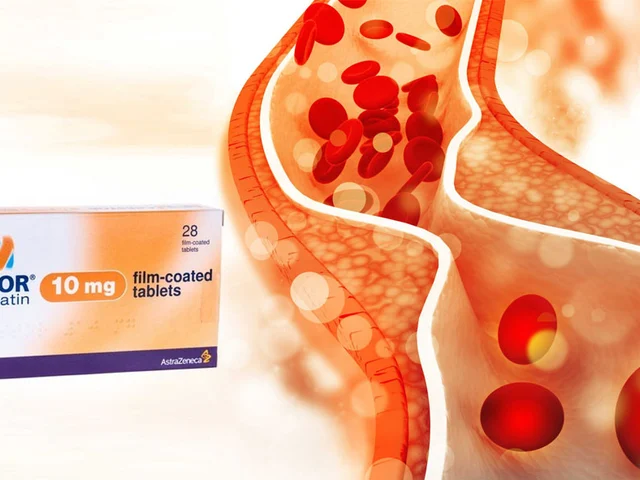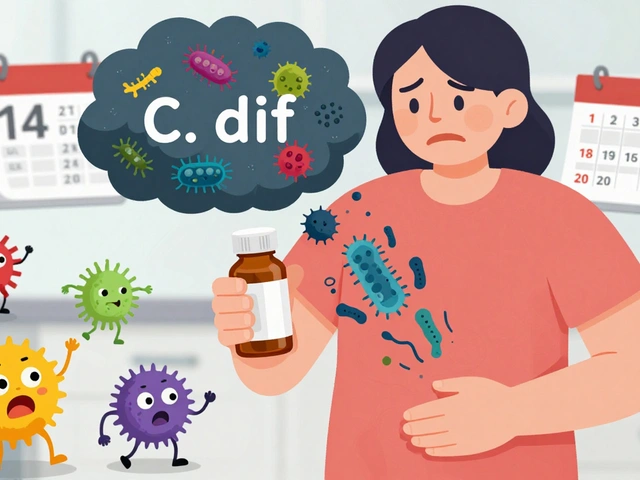Fournier's Gangrene Emergency Signs Checker
Check Your Symptoms
This tool helps you determine if your symptoms match the emergency signs of Fournier's gangrene for people taking SGLT-2 inhibitor diabetes medications. If you experience any of these symptoms, seek emergency medical care immediately.
Most people taking SGLT-2 inhibitors for type 2 diabetes never hear about Fournier’s gangrene. It’s rare. But when it happens, it’s life-or-death-and it can strike fast. If you’re on one of these medications, you need to know the signs before it’s too late.
What Is Fournier’s Gangrene?
Fournier’s gangrene isn’t just a bad infection. It’s a rapidly spreading, tissue-killing bacterial attack that targets the genitals, perineum, or anal area. The bacteria eat through skin, fat, and muscle-sometimes within hours. It’s called necrotizing fasciitis, and it doesn’t care if you’re young or old, male or female. What it does care about is a warm, moist, sugar-rich environment. That’s exactly what SGLT-2 inhibitors create.
Which Diabetes Drugs Are Linked to This?
The drugs tied to Fournier’s gangrene are the SGLT-2 inhibitors: canagliflozin (Invokana), dapagliflozin (Farxiga), empagliflozin (Jardiance), and ertugliflozin (Steglatro). These medications work by making your kidneys flush out excess sugar through urine. That sounds good for blood sugar control-but it also means your genital area gets flooded with glucose. Bacteria love sugar. Fungi love it even more.
Between 2013 and 2018, the U.S. FDA recorded 12 cases of Fournier’s gangrene in people taking these drugs. Since then, more have come in. In New Zealand, Medsafe reported multiple cases linked to empagliflozin and dapagliflozin. The UK’s MHRA received six confirmed reports by early 2019. The numbers are small, but the outcomes? Devastating.
Why This Is Different From Typical Infections
Most people think of yeast infections or UTIs when they hear about SGLT-2 side effects. Those are common-and usually treatable. Fournier’s gangrene is not. It starts like a bad yeast infection: itching, redness, swelling. But then it escalates. Pain gets worse than the visible damage suggests. Fever hits. The skin turns dark. You might notice a foul smell or pus. That’s not a sign to wait and see. That’s an emergency.
Here’s what makes this different: Fournier’s gangrene used to be seen almost exclusively in men. Now, about one-third of cases linked to SGLT-2 inhibitors are in women. A 71-year-old woman on dapagliflozin developed a massive perianal abscess. A 47-year-old woman on canagliflozin had tissue death spreading from her vulva. These aren’t outliers. They’re part of a pattern.
Emergency Signs: Don’t Wait
If you’re on an SGLT-2 inhibitor and you notice any of these, go to the ER now:
- Sudden, severe pain in the genitals or around the anus
- Redness, swelling, or warmth that spreads quickly
- Fever or chills
- Foul-smelling discharge
- Purple or black patches on the skin
- Feeling generally awful-like you’re coming down with the flu, but worse
Pain that feels out of proportion to what you see? That’s a classic red flag. Many patients report intense pain before any visible changes. Don’t dismiss it as a rash or irritation. If you’re unsure, call your doctor. If they’re not available, go to the hospital. Every hour counts.

What Happens If It’s Not Treated?
Fournier’s gangrene kills. Between 7% and 50% of people die from it, depending on how fast they get help. In the cases linked to SGLT-2 inhibitors, the mortality rate was around 16%. That’s still too high. Most patients needed intensive care. Nearly 80% required multiple surgeries to cut out dead tissue. Some needed skin grafts. Others lost organs. A few didn’t survive.
One patient described waking up with unbearable pain, thinking it was a bad UTI. By morning, the skin on her perineum was black. She spent weeks in the hospital. Her recovery took months. She still has nerve damage. She’s lucky to be alive.
What Do Doctors Do When They Suspect It?
There’s no lab test that confirms Fournier’s gangrene right away. Diagnosis is based on symptoms, physical exam, and imaging like CT scans. Once suspected, treatment starts immediately:
- Stop the SGLT-2 inhibitor-right away.
- Start broad-spectrum IV antibiotics.
- Surgery to remove dead tissue. Often, multiple procedures are needed.
- ICU monitoring for sepsis and organ failure.
- Switch to another diabetes medication that doesn’t raise this risk.
There’s no time for delays. If you’re in the ER and you’re on an SGLT-2 inhibitor, tell them. Say: “I’m on Jardiance/Farxiga/Invokana and I think I might have Fournier’s gangrene.” That speeds up the response.
Should You Stop Taking Your Medication?
No-not unless you’re having symptoms. These drugs save lives. They lower the risk of heart attacks, heart failure hospitalizations, and kidney failure in people with type 2 diabetes. That’s why regulators like Medsafe and the FDA still say the benefits outweigh the risks. But you need to be informed.
If you’re on one of these drugs and you have no signs of infection, keep taking it. But know the warning signs. Talk to your doctor about your personal risk. Are you overweight? Do you have poor circulation? Have you had genital infections before? Those factors raise your chance.

What If You’re Worried About Switching?
If you’re concerned, don’t stop your medication on your own. Talk to your doctor. There are other diabetes drugs that don’t carry this risk: metformin, GLP-1 agonists like semaglutide, DPP-4 inhibitors, or insulin. Your doctor can help you switch safely without letting your blood sugar spike.
Some patients feel guilty about switching-like they’re giving up on a “better” drug. But protecting your body from a rare but deadly infection isn’t giving up. It’s being smart.
How to Stay Safe
Here’s what you can do right now:
- Know the symptoms. Bookmark this page. Share it with someone you trust.
- Check your genital area daily. Look for redness, swelling, or sores.
- Keep the area clean and dry. Change underwear daily. Avoid tight clothing.
- Don’t ignore itching or discomfort. Treat yeast infections early with OTC antifungals-but if it doesn’t improve in 2 days, see a doctor.
- Tell every new doctor you see that you’re on an SGLT-2 inhibitor. It’s not just a side note-it’s a red flag.
If you’re a caregiver for someone with diabetes, watch for changes in behavior. Someone with Fournier’s gangrene might seem confused, lethargic, or unusually irritable. That’s sepsis talking. Don’t wait for a rash to appear.
Final Thought: Knowledge Is Your Shield
Fournier’s gangrene is rare. But it’s real. And it doesn’t care if you’re careful, healthy, or young. It only cares if sugar is present-and if you’re unaware.
You don’t need to be afraid of your medication. You need to be informed. If you catch it early, you can survive. If you ignore it, you might not get another chance.
Can Fournier’s gangrene happen to women?
Yes. While Fournier’s gangrene was once thought to affect mostly men, cases linked to SGLT-2 inhibitors show nearly equal rates in women. About one-third of reported cases in the EU and UK were in women. Age, diabetes, obesity, and trauma to the area increase risk regardless of gender.
How soon after starting the drug does Fournier’s gangrene develop?
Most cases occur within the first few months of starting the medication. The FDA found that patients developed symptoms an average of 3 to 6 months after beginning treatment. But cases have been reported as early as 2 weeks and as late as 2 years after starting. There’s no safe window-you need to stay alert as long as you’re on the drug.
Is it safe to take SGLT-2 inhibitors if I’ve had a yeast infection before?
Having recurrent yeast infections increases your risk. It means your body already has a tendency for fungal overgrowth in the genital area. SGLT-2 inhibitors make this worse. Talk to your doctor about alternatives. If you’re on one of these drugs and get frequent yeast infections, it’s a warning sign to reassess your treatment plan.
What should I do if I notice swelling or pain but no fever?
Go to the emergency room anyway. Fever isn’t always present in early stages. Pain, redness, swelling, or foul discharge are enough to warrant immediate evaluation. Waiting for fever could mean losing valuable time. Fournier’s gangrene progresses fast-don’t wait for all the symptoms.
Are there any long-term effects after surviving Fournier’s gangrene?
Yes. Many survivors need multiple surgeries and skin grafts. Some lose part of their genital tissue. Others suffer chronic pain, nerve damage, or sexual dysfunction. Recovery can take months or years. Psychological trauma is also common. Early detection and treatment reduce long-term damage-but prevention is far better.











David Barry
Let’s be real-SGLT2 inhibitors are basically sugar sprinklers for your nether regions. The FDA’s 12 cases? That’s the tip of the iceberg. Hospitals are seeing more now, but nobody’s tracking the subclinical cases where people just get recurrent yeast infections and chalk it up to ‘bad hygiene.’ That’s the real red flag. Sugar in urine isn’t a side effect-it’s a biological invitation.
Alex Ramos
Been on Jardiance for 2 years. Never had an issue. But after reading this, I checked myself-no redness, no smell, no pain. Good. But now I’m checking weekly. Also told my wife to watch for me if I’m extra grumpy or feverish. This stuff is silent until it’s not. Thanks for the heads-up. 🙏
edgar popa
if you got diabetes and dont know the signs of this you probly dont deserve to live
Benjamin Stöffler
It’s fascinating how we’ve engineered a class of drugs that optimize glycemic control by exploiting renal physiology-only to inadvertently cultivate a microbiological paradise in the perineal region. The irony is almost Aristotelian: we treat metabolic dysfunction by creating a new, localized dysbiosis. The body doesn’t ‘fail’ here-it responds precisely to the biochemical environment we’ve created. The real failure is in our clinical oversight, our assumption that ‘rare’ means ‘irrelevant.’
And yet, the pharmacokinetics are impeccable. The glucose excretion is elegant. The cardiovascular benefits? Undeniable. So why do we treat this as a black-and-white risk-benefit equation? It’s a spectrum. A gradient. A threshold effect. Some patients have compromised immune surveillance, poor hygiene, or pre-existing fungal colonization. For them, this isn’t rare-it’s inevitable.
And yet, the medical community still treats it like an outlier. Why isn’t every patient on an SGLT2 inhibitor given a printed checklist? Why isn’t there a mandatory pop-up in EHRs? Why is the burden of vigilance placed entirely on the patient?
Because we still think of patients as passive recipients, not active agents in their own survival. We’ve outsourced risk management to Google searches and Reddit threads. That’s not medicine. That’s negligence dressed in white coats.
And yes, women are getting it too. Not ‘sometimes.’ Not ‘rarely.’ In nearly a third of cases. And we still call it a ‘male’ condition in textbooks. That’s not ignorance. That’s institutional bias.
So yes-stop the drug if symptoms appear. But also-demand better systems. Because this isn’t about individual responsibility. It’s about systemic accountability.
Eve Miller
People need to stop treating their diabetes like a game of Russian roulette. If you're on one of these drugs and you're not checking your genital area daily, you're not managing your health-you're gambling with your life. This isn't 'maybe' or 'probably.' It's 'if.' And if you wait for fever, you're already too late. Stop being lazy. Stop being embarrassed. Your dignity means nothing if you're dead.
Chrisna Bronkhorst
Let me cut through the noise-this isn’t about the drug. It’s about the patients who don’t tell their doctors they’ve had three yeast infections in six months. It’s about the GPs who don’t ask the right questions. It’s about the ERs that dismiss ‘genital discomfort’ as ‘hormonal’ or ‘stress.’ The drug is just the spark. The real fire is the system ignoring the smoke.
Amie Wilde
my doctor never mentioned this. i’m on farxiga. i think i’ll ask next time. also i’m kinda freaked out now lol
Mark Rutkowski
There’s something deeply human about this whole situation. We want our medicine to be elegant-clean, precise, almost poetic. A pill that flushes out sugar like a gentle tide. But biology doesn’t care about elegance. It cares about opportunity. And when you flood a warm, moist crevice with glucose, you’re not just treating diabetes-you’re throwing a banquet for microbes that have been waiting for centuries to feast.
And yet, we’re shocked when they show up. We act like this is a betrayal. But it’s not. It’s physics. It’s chemistry. It’s evolution.
Maybe the real question isn’t whether we should stop these drugs-but whether we’ve been naive to think we could outsmart our own biology with a single mechanism. Maybe the answer isn’t just vigilance. Maybe it’s humility.
These drugs save lives. But they also remind us that we’re not gods. We’re guests in a body that’s older than our science, smarter than our algorithms, and far more cunning than our assumptions.
So take the pill. But don’t forget to look down. And thank your body-for letting you live long enough to learn this lesson.
Ryan Everhart
so you’re telling me i need to check my junk daily because a pill makes my pee sweet? wow. thanks for the life advice doctor. maybe next you’ll tell me to stop breathing because air has oxygen and oxygen causes cancer?
just kidding. kinda. but seriously-this is why people don’t trust medicine anymore. Every other month it’s ‘this drug will kill you’ and the next month it’s ‘this drug will save you.’ pick a lane.
Alyssa Lopez
as a woman with type 2 i’ve had 4 yeast infections in 10 months on farxiga. my dr said ‘its common’ but i knew something was off. i went to the er when i got a fever and black spots. they did a ct and said ‘thank god you came in.’ i lost tissue. i’m on metformin now. if you’re on one of these and get recurrent yeast infections-dont wait. its not ‘just a yeast infection.’ its a warning sign. and if your dr dismisses you-get a new dr. your life matters more than their convenience.